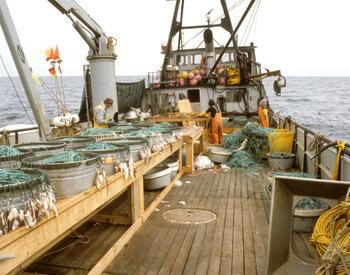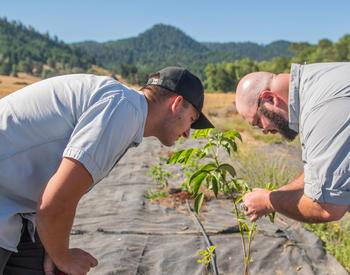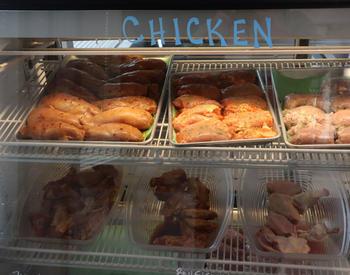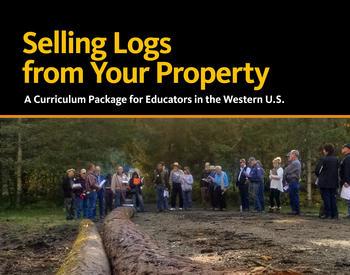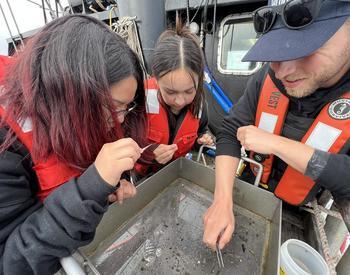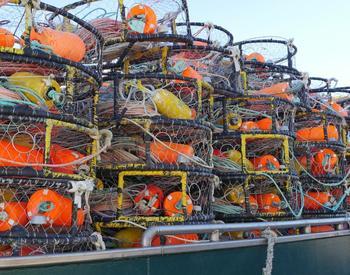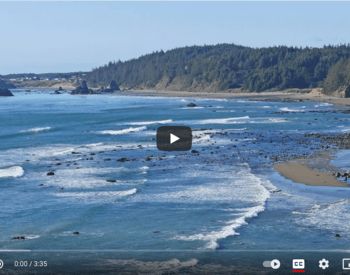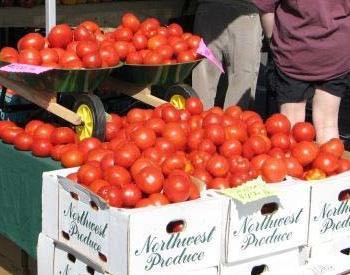Transcript
Call to mind the most incredible seafood meal that you've ever eaten. Take just a few seconds to revel in that memory. What was the seafood that you had in that meal? Think about what enticed you as you got ready to eat. Think about how the meal was plated. The shapes, colors, and arrangement. Now think about that first perfect bite. What were the textures, aromas, and flavors that made the dish so incredible? Who shared that incredible meal with you? Do you remember the conversation you had with them? Finally, where were you? With family? At a friend's house? At home? If you're anything like most Americans, there's a good chance you're eating that incredible seafood meal out at a restaurant. That’s because 65 percent of American seafood expenditures are in restaurant settings, and we tend to eat fancier seafood at restaurants than we do at home. But, what happens when you can't go out to the local restaurant to get your favorite seafood dish?
Now take yourself back to March of 2020 as the drumbeat of COVID-19 restrictions started beating louder and louder in all of our lives. Oregon’s fishing families had already begun to feel the impact. Many fisheries lost their export markets in late January as the spread of the virus shut down Lunar New Year celebrations all across Asia. Prices for Dungeness crab were stagnant at a time when they normally would be rising. The stay-at-home order was issued, and restaurants closed here in Oregon. It further devastated our seafood producers. Suddenly, Oregon seafood was off the menu. Seafood processors couldn't find markets for their ground fish fillets and other products, so they started putting seafood in the freezers instead. But, there was only so much space in the freezers, and frozen products often sell for less than fresh even though they are very high quality. Some vessels cut their season short. It just didn't pencil.
At the same time we were experiencing profound disruptions in our own lives. We transitioned to remote work, canceled or postponed programs we had planned for the first few weeks of lockdown. Initially, we felt powerless. What could we, as scientists, as educators, do in the face of this unprecedented crisis? We didn't have the power to magically fix these problems but we quickly realized we did have the tools and training we needed to document the impacts and to inform the recovery process.
In late April, with our colleague Jamie Doyle, we launched an online survey to understand the impacts of COVID-19 on the Oregon seafood industry. We distributed our survey to fishermen, aquaculture practitioners, seafood processors, retailers, and integrated businesses. Those that participated in multiple sectors of the industry. We heard from people in all sectors and across the coast. Nearly everyone reported that they or their business had been already impacted by COVID-19 and that they were highly reliant on the seafood industry for their livelihood. Across all sectors, the loss of markets was cited as the most pressing key concern.
At the same time, Oregon families were doing their best to adjust to the dizzying upheaval of their normal lives. Many experienced serious financial hardships. Parents were trying to work from home, supervise kids’ online schooling, and still get a healthy meal on the table at the end of the day. Through it all, however, communities were coming together to help each other. Supporting local, buying local was a rallying cry for people concerned about the economic impacts of COVID-19 on their community.
Americans only get a fraction of the recommended amount of seafood in their diets under normal circumstances, let alone during a pandemic. We wanted to find a way to nourish Oregonians as well as our local communities. That multifaceted goal was what sparked the “Eat Oregon Seafood" initiative Starting in May, Angie, Jamie, and I partnered with the Oregon Department of Agriculture to launch the Eat Oregon Seafood campaign on social media. During the summer, our partners at Oregon Department of Agriculture recruited famous chefs and foodies to develop recipes using a wide range of Oregon seafood. Their posts on social media reached more than one million people using the hashtag #EatOregonSeafood. This fall we have continued to recruit home chefs, and ask you, and them, to share their favorite Oregon seafood recipes.
At the request of ODA and Oregon’s Fishing Families, we developed a website with information about the types of seafood harvested in Oregon, a map showing where to buy it, and a recipe archive to inspire Oregonians to cook seafood at home. We have also harnessed the power of video to reach wider audiences during this time of increased social distancing. We worked with Kelly Street of OSU Extension Clackamas County to create a video on how to safely can seafood at home. We worked with Buck Jones of the Columbia River Inter-Tribal Fish Commission to create a video on how to buy salmon and other seafood directly from tribal fishers on the Columbia River Gorge. And our efforts have inspired others to create their own social media campaigns focused on local seafood.
Economic recovery from COVID-19 won't be easy for anyone, and our fishing communities are no exception. We do know that Oregonians and our coastal communities are resilient, however, and willing to work together to overcome these challenges. We hope that by strengthening connections between land and sea, industry and consumer, food and family, that Oregon’s fishing communities can begin to thrive again and that Oregonians can gain the long-term health benefits of more seafood in their diets. We know we can make it through together.
The Eat Oregon Seafood initiative will continue through the end of next summer with support from the national Sea Grant program. We're going to continue building out our seafood educational resources for consumers, including the development of new videos. And we will be expanding and relaunching our Eat Oregon Seafood website. We hope you'll join us and be part of the initiative. Ask your favorite restaurant where they source their seafood, and whether they serve Oregon products like Dungeness crab, rockfish, pink shrimp, albacore tuna, troll, and tribal-caught salmon. Share some of your favorite recipes on social media using the hashtag and send it to us so we can add it to our archive. We hope that the next incredible seafood meal that you eat features Oregon seafood cooked in your very own home kitchen, and that with your help we can support our fishing families and get Oregon seafood back on the menu.
Seafood producers, and the working waterfronts they support, are central to the cultural identity, economic vitality, and food security of all Oregonians, and contribute significantly to the seafood supply of the nation. When COVID-19 prompted stay-at-home orders, it was immediately clear there would be profound impacts on Oregon’s seafood industry and coastal communities.
The Oregon Sea Grant Fisheries Extension team recognized the immediate need to understand the impacts and respond in a way that supported both the seafood industry and consumers.
Leveraging the trends to “make it through together” and “support local,” the Sea Grant team partnered with the Oregon Department of Agriculture (ODA) and others to launch the Eat Oregon Seafood Initiative (#EatOregonSeafood). Visit the website at www.EatOregonSeafood.org.
Hear from:
- Angee Doerr, Assistant Professor of Practice, Oregon Sea Grant, OSU Extension Service - Lincoln county
- Jamie Doyle, Coastal Development Specialist, Oregon Sea Grant, OSU Extension Service - Coos County
- Amanda Gladics, Assistant Professor of Practice, Oregon Sea Grant, OSU Extension Service - Clatsop county.
Learn about the survey that included 97 total harvesters, 29 total retailers and 20 total processors (of which 20 were integrated businesses identified as more than one seafood industry sector).
Then explore other resources:
- www.EatOregonSeafood.org
- How to safely can your tuna at home video
- Oregon Sea Grant seafood recipes
- #EatOregonSeafood and #10DaysofTuna
